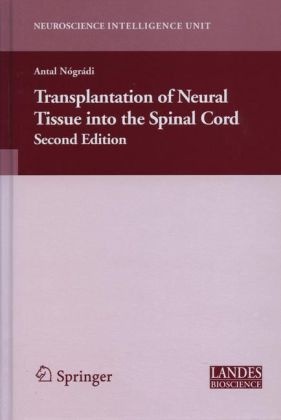Mehr lesen
Transplantation of Neural Tissues into the Spinal Cord presents both recent and early results from various experiments where grafts of neuronal, glial and other tissues, as well as artificial materials, were placed into the spinal cord. This book is evaluates the contribution and effect of these studies to our understanding of basic neurobiological questions. This second edition of the book provides answers to many questions which could not be answered in the first edition, and accordingly all the chapters have been extensively rewritten and edited. The findings summarized in this edition show that grafted tissue can survive and thrive in a host mammal, occasionally replace some lost function and re-establish a semblance of sophisticated and complex circuitries. These new insights are among the most exciting in neurobiology, for they challenge the view that nothing can grow or regenerate in the central nervous system and give new hope that it may be possible to treat some of the incurable diseases of the CNS.
Inhaltsverzeichnis
Introduction.- Anatomy and Physiology of the Spinal Cord.- Recovery of Function after Spinal Cord Injury.- Recovery of Lost Spinal Cord Function by Facilitating the Spinal Cord Circuits Below the Lesion.- Encouraging Regeneration of Host Neurones: the Use of Peripheral Nerve Bridges, Glial Cells or Biomaterials.- Encouraging Regeneration of Host Neurones: Transplantation of Neural Tissues into the Injured Spinal Cord.- Replacement of Specific Neuronal Populations in the Spinal Cord.- Replacement of Specific Populations of Cells: Glial Cell Transplantation into the Spinal Cord.- Index.
Zusammenfassung
The book gives an account of results obtained from experiments where grafts of neuronal, glial and other tissues as well as artificial materials were placed into the spinal cord. It attempts to evaluate the contributions made by these studies to our understanding of basic neurobiologies questions. These include factors that regulate neuronal growth during development as well as regenera tion following injury to the nervous system. The model of neural transplanta tion is also useful for the study of cell-to-cell interactions, and this applies to interactions between glial cells and neurones, between various populations of neuronal cells and finally between axons and skeletal muscle fibres. The mecha nisms involved in the establishment of specific synaptic connections between neurones can also be investigated in this experimental paradigm. Important in formation regarding this issue was also obtained on systems other than the spinal cord, i. e. the cerebellum, hippocampus and striatum. Although such in formation of precise connections between the host and the grafted embryonic tissue is still lacking in the spinal cord, there is much information on the re sponse of the host nervous system to the grafted embryonic tissue, and that of the graft to its new host environment. It appears that embryonic grafts are able to induce repair processes follow ing injury to the nervous system.
Zusatztext
From the reviews of the second edition:
"This book is organized into 5 major chapters assessing spinal cord injury as well as replacement strategies targeting different cellular populations. … will be of teaching value to students in the field of neuroanatomy and spinal cord injury. … Images throughout the book are easy to read, with appropriate figure legends to explain the major conclusions … . I would recommend this book to audiences interested in spinal cord injury and the discussion of novel strategies directed toward repairing the injured cord." (American Journal of Neuroradiology, May, 2007)
Bericht
From the reviews of the second edition: "This book is organized into 5 major chapters assessing spinal cord injury as well as replacement strategies targeting different cellular populations. will be of teaching value to students in the field of neuroanatomy and spinal cord injury. Images throughout the book are easy to read, with appropriate figure legends to explain the major conclusions . I would recommend this book to audiences interested in spinal cord injury and the discussion of novel strategies directed toward repairing the injured cord." (American Journal of Neuroradiology, May, 2007)

